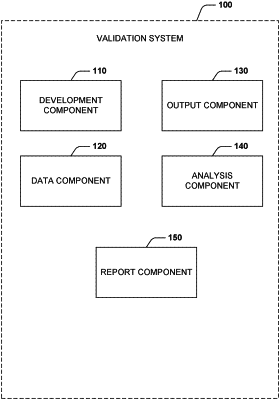| CPC G06Q 10/0635 (2013.01) [G06N 20/00 (2019.01)] | 20 Claims |

|
1. A computer-implemented method, comprising:
identifying a risk model for validation, the risk model including a first data set and a plurality of result data sets corresponding to the first data set and the risk model, the plurality of result data sets including a first set of analysis results, a first set of coefficients, a first set of transformations, and a first set of variables including a first set of transformed variables and a first set of untransformed variables;
performing a replication validation of the risk model, the replication validation of the risk model including:
analyzing the first data set with a logistic regression model to produce a second set of analysis results including a second set of coefficients, and
comparing at least one portion of the first set of analysis results to at least one portion of the second set of analysis results;
performing a transformation benchmarking validation of the risk model, the transformation benchmarking validation of the risk model including:
inputting the first set of untransformed variables and the first data set into a first machine learning algorithm to produce a second set of transformations and a second set of transformed variables, and
comparing at least one portion of the first set of transformed variables to at least one portion of the second set of transformed variables;
performing a predictive performance benchmarking of the risk model, the predictive performance benchmarking of the risk model including:
identifying an extended feature set of variables;
selecting a second set of variables from the extended feature set of variables with a second machine learning algorithm, and
comparing at least one portion of the first set of variables to at least one portion of the second set of variables; and
generating a digital report based on comparison of the at least one portion of the first set of analysis results to the at least one portion of the second set of analysis results, comparison of the at least one portion of the first set of transformed variables to the at least one portion of the second set of transformed variables, and comparison of the at least one portion of the first set of variables to the at least one portion of the second set of variables.
|